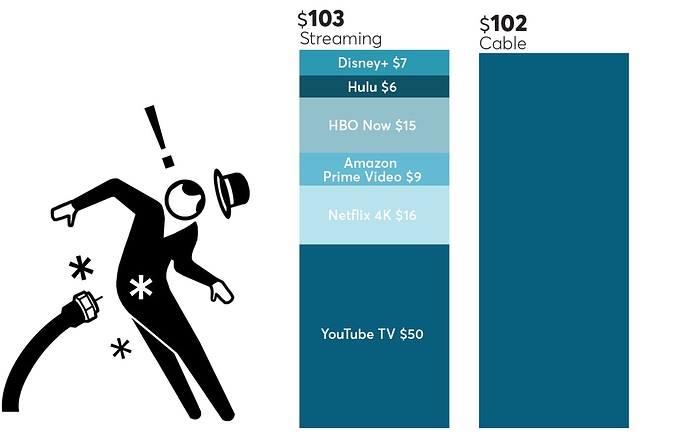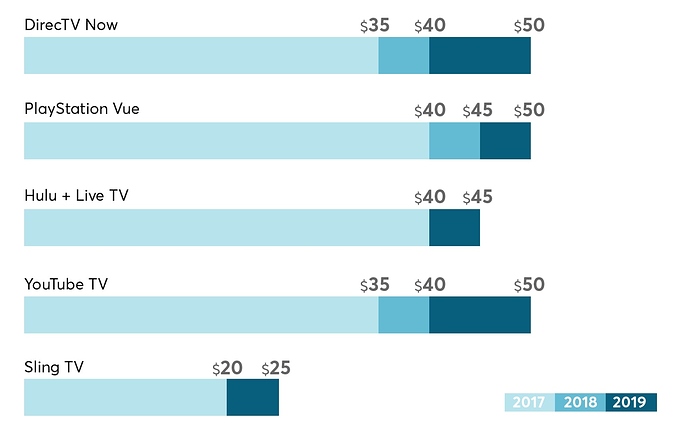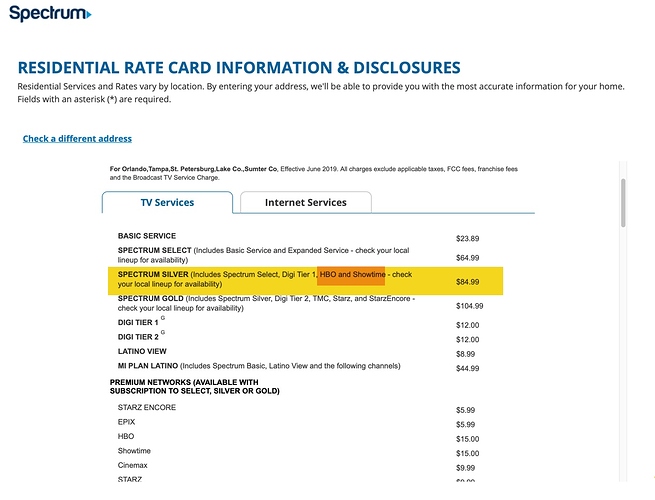I’m a type 2 have Tablo for my local networks, subscribe to Philo $16 for my Science, History, Travel and other channel that other folks find them boring have netflix, Hulu, Prime, Crunchyroll ( anime from Japan daugther pay for) and Vudu convert most of my bluray to digital almost 300 movies there.
Definitely a full 3 here. Other than our overpriced internet service and the yearly subscription to Tablo for the guide we pay for no other services.
I am mostly a 3, with the occasional 2 (netflix) thrown in for good measure
In the September 2019 edition of Consumer Reports there is an article called:
The Cord-Cutting Decision Is Tougher These Days. Here’s What You Need to Know
Every year, more Americans decide to fire their traditional pay-TV provider, whether that’s a cable service or a satellite TV company. In 2018, the traditional U.S. pay-TV providers lost more than 3 million subscribers, according to the industry analysts Leichtman Research Group…If you’re thinking of going the cord-cutter route, the decision is more complex than it was just a year ago.
They talk about how over the past year the calculation became more complex.
Quite a few people get by with just a streaming service, such as Hulu or Netflix, especially if they can get good TV reception using an antenna.
But putting together your household’s strategy for TV entertainment is trickier now. Whether you decide to stick with cable, opt to cut the cord and sign up with a cable-replacement service, or decide to just stream videos from a service such as Hulu or Netflix, you might not get everything you want from a single service—or even two.
More than 70 percent of U.S. households that use streaming services subscribe to more than one, according to the research firm Ampere Analysis. Just under a quarter subscribe to three services, and nearly 20 percent have signed on to four or more services.
The legions of Americans abandoning cable TV aren’t necessarily going on a content diet. Many are “stacking” a variety of online streaming video services to get an à la carte combo of channels, shows, and movies.
At the same time the cost of these services is going up…
The old world of TV entertainment was easy for people to understand, but the lack of choice was frustrating. The new world is complicated but ultimately has much more to offer.
The Consumer Reports article is ridiculous if not utter nonsense. Unworthy of reading (it’s just worthless).
So… reality. People don’t subscribe to EVERY streaming thing they can find. They just don’t.
Of course, we here know the secret to very cost effective cord cutting, that is, no commercial streamers, just use free OTA!!
But, with that said, most of those “Cable” folks subscribe to Netflix and/or Amazon Prime already. Not shown in their graph. But even if not (which again is a lie in probably >90%)… there are other “facts” not seen here. Like if you’re a Sprint customer you get Hulu for free. If you’re a T-mobile phone customer you might get Netflix for free. (depends on plan, but often times, you’ll find you have access to these benefits). ATT gives you HBO Now, etc…
So both graphs are very very wrong. Very very misleading.
So, we have cordcutting, anyone for magazine trashing? Starting with Consumer Reports.
Many of the media giants are branching out with their own services as well. Hulu started as a “consortium” of partnerships, not anymore. Who knows where AT&T HBO DirecTV is going to end up and Disney or Discovery - each “cable channel” seems to want their own service.
So, maybe people can finally get more of an a la carte instead of a useless package, but it looks like the beast is finally waking up.
I don’t know why you say that. It is a fair article. The chart is just showing what you can get for the same price as cable, not what a cord cutter has to get. If a consumer wants to save more money than cable, they certainly can.
The toughest part is whether a consumer can live without a streaming cable package, like YouTube TV, Sling, Playstation Vue, etc. That usually is the only source for most sports, as well as traditional cable stations.
My OTA tv watching is maybe 1% of my video content viewing. I spend a whole lot more time on YouTube and streaming services.
Wow. You really don’t see that article as being hogwash. Interesting.
I guess cutting the cord is a dollar more than keeping cable after all. 
I think they can 'splain it how they want if they never actually define what cord-cutting is. Oddly it has various meanings and if you toss out stats on a vague topic…
If you drop your cable subscription, but pay the same cable company $$$ for internet service, they aren’t necessarily the media content provider, they still profit from services.
Studies, statistics and analysis, first have to know what a successful one looks like, before it gets funded. We only know what “they” want us to know.
It can be. Do you deny that?
It depends on what content the consumer wants. Want to watch baseball, hockey, NBA, or college sports? Then you better be prepared to pay $50 a month. Want to watch a variety of movies and TV shows? Then you likely will need to subscribe to multiple services.
Some people are fine with OTA tv, and that makes cord cutting very inexpensive. But I would think most want more than that.
But the bar charts ARE garbage. If you want HBO, you have to put in in both columns. Same for Disney+. And Netflix and Amazon if you want the original programming.
with the term “Live TV” services, “cable networks/channels” with out cable… are you really cutting-the-cord? or just using wires, or a different method to continue with the same content.
Saying, “I switched to internet streaming services to watch cable networks”, so you can claim – yup I’m a cord-cutter? Now you’re using a analytical proprietary OTT device working across your home network, checking a box; sure I agree to what ever you want to do.
Good call on that one, it’s something most of these type of “surveys” gloss over, using charts / graphs as a sort of slight-of-hand. While subscribed to cable, I also had a monthly for Hulu, Amazon Prime and Netflix (such as you mention). Gave up cable one year ago (along with Hulu and Netflix), now watching whatever the antenna pulls in (56 channels), Amazon Prime and Philo.
Went from $256.00 per month to $29.00.
WOW – Good move but you waited too long. I am very happy with 82 ota channels and Netflix and Amazon Prime mostly for shipping. Cheers.
I did wait too long, way too long, it wasn’t until I stumbled upon a Tablo one night in a Best Buy that it all changed … one year ago. Up until then, I’d been spending all that money (over $3,000.00 per year) while (ironically) spending less than a few hours a week in front of the boob tube to begin with.
Amazon Prime … I also use it primarily for the free shipping, unfortunately I spend much more on Amazon than I ever did on cable (ouch).
NO. Look around. Most cable packages (internet / TV) at that price include Showtime and HBO among many other fee based channels.
Also, the article is written from the perspective of a family looking into the possibility of changing they way they get video entertainment. It is not about hard core cord cutters like some of the people here. Many families have different wants and preferences above just saving money.
So the article is not “wrong” but only presents one perspective, different from many here, to help people think about what they want and what they are willing to pay for what they want.
Not everyone wants just OTA, I don’t, and make choices accordingly.
EXAMPLE:
In the “early days” the articles were about dropping cable and save heaps of money. Now, well it’s not about saving money? nor washing hogs?
Consumer Reports, from what I understand, generally do their own independent research. In this article, first reference stats from an industry analysts,Leichtman Research Group. Next quote someone from the media research firm Frost & Sullivan. Go on to cite stats and projections according to the research firm Ampere Analysis. Finally reference one of their own articles. All of these companies are demographic marketing research businesses. They provide service to giant corporations! Stats aren’t just done because, so only the information they want the public to know, gets released… hey, we did a study - here’s what we found.
The article notes with streaming services you’ll still “decent broadband service” (vague weasel words) yet don’t include this in the cost chart - what’s up with that?
Haven’t dug in, the bar shows Hulu + Live $45, the stacked show we have Hulu and Youtube TV… instead just add Live TV to Hulu saving $5. And unless I’ve got a new enough TV don’t need premium 4K Netflix, save another $3. 


Hardcore 2. I have a Shield with the 500gig internal HD that Tablo records local programing on. I use several apk’s to watch movies. Two IPTV apk’s for live programing, including world wide programs, around 2000 channels are available, even though a lot are in the language of the country of origin. They are $5 a month each. I subscribe to two in case one has a streaming problem. Then there is Kodi. I use Flosports, which is all sports. I cast it from my Mac Book Pro to the shield. I will be purchasing the Apple TV box so I will no longer have to cast Flosports. I know this sounds like a lot and may not be a true cord cutter but I lowered my cost by 75%. I had the Direct TV 5 channel DVR with all programing, $1620 a year. I now pay out $390 a year (US) for everything including Flosports ($150 a year) Tablo 14 day guide ($40) both IPTV’s ($120) and Real-Debrid ($80).

It’s mainly about paying for what you want to watch on devices that you own, including mobile, computers, and gaming consoles. The flexibility of being a cord cutter is huge now, even if the cost can come close to cable/satellite alone.
Now if a person lives in a rural area with limited internet, cord cutting is likely just using an antenna and possibly a DVR like the Tablo. Here in Tennessee, if you don’t live near a major city, you are probably stuck with DSL (despite all the promises of “rural broadband for all”).
Luckily, I live in Nashville with access to great internet and can stream anything (though it sucks that Google Fiber is a huge failure here).
On a side note, I was listening to local sports radio about how Dish dropped NBC here, and if you call them to complain, they will ship an antenna to you to receive that channel (plus discount your service). The radio host still complained that he didn’t want an antenna and just wanted all the local channels through his service. Still, I wonder if these satellite companies will try the antenna route more and more as these local channels keep demanding more and more money.
That’s what was meant about loosely defining cord-cutter. Leaving it wide open doesn’t give the article much foundation. Defining would provide perspective.
“stuck with DSL” with copper wires buried, maybe, +50yrs ago? Doesn’t DSL require proximity to “central office”? …in a rural area?
Isn’t rural TN in the Appalachian Mountains or it’s foot hills? I image they’d be happy to be stuck with DSL.
In what seems out-of-character
“FCC finally orders ISPs to say exactly where they offer broadband ISPs will have to submit geospatial maps of broadband service areas.”
But I don’t think much will ever happen. As long as they pretend cell service counts as broadband service, kind of ends it.


